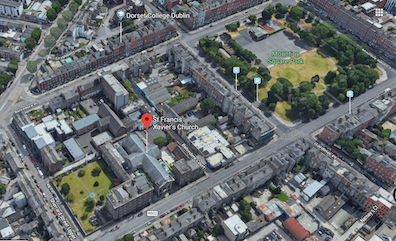Although the name of the church is not mentioned for several
more pages, the 1st section of Wandering Rocks begins
in front of "saint Francis Xavier's church, upper Gardiner
street." Leaving his residence just north of the church, the
Reverend John Conmee is seen coming "down the presbytery
steps." His thoughts are interrupted less than a minute later
by a "onelegged sailor" who "jerked short before the
convent of the sisters of charity and held out a
peaked cap for alms." This convent just south of the church
mirrors the presbytery in appearance. The three buildings
stand one block northwest of the park in "Mountjoy square,"
near Dublin's northeastern edge, and not far east of the
Bloom's house in Eccles Street.
The church of St. Francis Xavier, often called the Gardiner
Street Church, was built between 1829 and 1832 by architect
John B. Keane, immediately after Catholic
Emancipation in 1829. One of the better looking churches
in Dublin, it reflects the influence of models in Paris and
Italy. A Regency-style "presbytery," or domicile for
priests, and a matching convent were constructed on either
side of the church, both of them featuring handsome doorways,
plasterwork, fireplaces, and other fittings in an expression
of national Catholic pride. The Jesuit
priests of the church also served as chaplains in the convent.
Today, the church and the presbytery are preserved by
inclusion on Dublin's Record of Protected Structures, but the
convent was unaccountably omitted. As of 2016 it was being
offered for sale, and it appears to have been converted into a
hostel.
Although none of the action of Ulysses takes place
inside the church, readers of Dubliners will recognize
it as the site of the religious retreat led by Father Purdon
in "Grace." In the short story Martin Cunningham
plays up the Jesuits to Tom
Kernan as "the grandest order in the church." Mr. Power
chimes in that they are a "fine body of men." Mr. M'Coy adds that "The Jesuits
cater for the upper classes." As Gifford notes, the Mountjoy
Square area was "relatively fashionable" at the time
represented in the novel, though today it is "sliding into
dereliction."
After his rather shabby treatment of St. Xavier's in Dubliners,
Joyce seems to have made amends in Ulysses. In Eumaeus,
Bloom displays pride in Molly's having performed splendidly in
"the jesuit fathers' church in upper Gardiner street"
as one of the soloists in Rossini's Stabat Mater, "the
sacred edifice being thronged to the doors to hear her with
virtuosos, or virtuosi rather. There was the
unanimous opinion that there was none to come up to her and
suffice it to say in a place of worship for music of a sacred
character there was a generally voiced desire for an encore."


